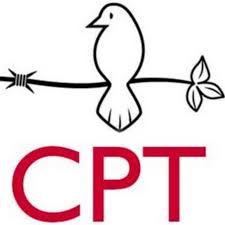No Place to Hide
Allana Gully. Photo by: Julie Brown
By Julie Brown
"When the bombing starts, where do you hide?" That is what I asked Sulltan.
"There is no place. Behind rocks, wherever we can. We all just run in every direction. Everyone has to find their own place. Even the children."
The last shelling started on June 23rd at 10am and did not stop until after noon. The farmer said over 160 bombs fell on the small area in those two hours. After it was over, many animals had been killed and three children were injured. It was this story that we heard in detail as we documented the events of that day.
In the Choman District of Iraqi Kurdistan High in the mountains near the Iranian border lies the Allana Gully. It was here that CPT visited after hearing reports of a recent cross border shelling from Iran. The drive through the mountains to this remote area was slow. The road is an unpaved rocky path that hangs on the sides of very steep mountain ledges. In many places it is so narrow that the wheels of our vehicle came dangerously close to sliding off the edge.
"When the bombings start, some families try to flee in their vehicles. You have seen the road, It is very dangerous." Sulltan pointed to the rugged path, it's the only road that leads down.
On this day there was no shelling and the sun as bright. We exited our vehicle next to a small grouping of canvas tents. Several gentlemen along with a few children approached as we introduced ourselves and our purpose for being in their village.
Sulltan showing his daughter's injury. Photo by: Julie Brown
Sulltan was one of the first people we met. As soon as Sulltan heard we had come to talk about the shelling from Iran he summoned a young girl with long blond hair. It was his daughter. He reached down and gingerly took her arm and lifted it up for us to see. He explained that she had been hit by shrapnel. Metal had entered her palm and lodged in her wrist. She had to have surgery to remove the shrapnel leaving a wound that went all the way through. As I took pictures of her injuries I could see the trauma on her face. Her eyes were red and swollen and her expressions did not match those of the other children that had now gathered around us. She was clearly still very traumatized.
Sulltan took us away from the tents further down the road. He stopped overlooking a small pasture full of grazing sheep and explained that twenty-five families farm the surrounding area every year. His family pays several thousand dollars each year for this land to farm and graze animals. Even with the shelling, they must stay because farming is their only source of income. He indicated that in this field was where the children were when they were injured, An 8yr old boy with bright curly red hair had injuries to his arm, a 13 year old boy had injuries to his neck and also his daughter had an injured wrist. All from shrapnel.
I looked at the field below. If shelling were to start, where would people go? There was nowhere. Only a few small rocks.
A group of children descended from the tent village toward us. They stopped to play in a small stream that snaked the side of the path and I took out my video camera. As I approached they all stood and looked at me. One of the children said "video" and pointed at my camera. For the next forty-five minutes the children and I took turns using the "video". I filmed them, they filmed me. There was laughing and smiling and we all used the camera as we walked slowly back to the tent village.
Children from Allana. Photo by: Julie Brown
Once we reached the tents we rejoined the larger group where the adults were finishing their last words about the bombing. The mood among the children immediately changed. They were more serious as they now stood with the adults, looking up and listening. Villagers had reported that members of the Kurdistan Democratic Party of Iran were thought to be in the area and that is what prompted the shelling. At first drones came, then the shelling started. It became clear that Iran had the use of surveillance drones yet still repeatedly targeted these farmers and their children. In other areas people reported that the targeting of civilians is a commonly used tactic. Many locals believe that they are targeted so that the civilians will force armed groups out of the area for various governments. The men, their wives, and the children in the Allana Gully only have dreams of farming and living in peace. Being used as pawns in a cross border conflict has caused nothing but destruction to these families for years.
Children reminded of recent shelling. Photo by: Julie Brown.
When I had handed my video camera to the children earlier that day I intended to capture what the world looked like through their eyes but there are things we can never fully see. What does bombing look like to a seven year old? What does it look like to try to hide alone behind a rock as the world explodes around you? How does the world look through the eyes of a twelve year old with shrapnel lodged in her body? How can children make sense of this when even the adults do not have the answers? I looked again at the girl with the injured hand and then at the rest of the children. I know It had only been a couple of weeks since the last shelling but can time possibly ever heal all of these wounds?
